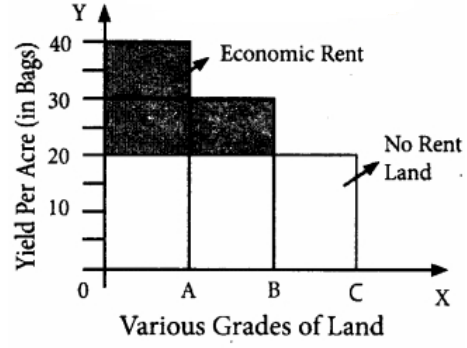1. The Classical Theory of Rent is called “ Ricardian Theory of Rent.”
2. “ Rent is that portion of the produce of the earth which is paid to the landlord for the use of the original and indestructible powers of the soil” – David Ricardo
Assumptions:
Ricardian theory of rent assumes the following:
1. Land differs in fertility.
2. The law of diminishing returns operates in agriculture.
3. Rent depends upon fertility and location of land.
4. Theory assumes perfect competition.
5. It is based on the assumption of long period.
6. There is existence of marginal land or norent land.
7. Land has certain “Original and indestructible powers”.
8. Land is used for cultivation only.
9. Most fertile lands are cultivated first.
Statement of the Theory with Illustration: There are three grades of land, namely A, B and C in that island. ‘A’ being most fertile ‘B’ less fertile and ‘C’ the least fertile. They will first cultivate all the most fertile land. The yield per acre on ‘A’ grade land is 40 bags of paddy.
The same amount labour and capital employed in ‘A’ grade land. The yield per acre on ‘B’ grade land is 30 bags of paddy.
The Surplus of 10 bags [40-30] per acre appears on ‘A’ grade land. This is “ Economic Rent” land of ‘A’ grade land.
The yield per acre on ‘C’ grade land is 20 bags of paddy. This surplus of ‘A’ grade land is now raised to 20 bags [40-20] and it is the “ Economic Rent” of ‘A’ grade land.
The ‘C’ grade land, cost of production is just equal to the price of its produce and therefore does not yield any rent [20-20], Hence, ‘C’ grade land is called ‘no-rent land or marginal land ’. The land which yields rent is called “intra-marginal land”.


Diagrammatic Explanation:
1. In diagram, X – axis represents various grades of land and Y axis represents yield per acre [in bags],
2. OA, AB and BC are the ‘A’ grade ‘B’ grade and ‘C’ grade lands respectively.
3. The ‘C’ grade land is the no – rent land.” .
4. ‘A’ land ‘B’ grade lands are “intra – marginal lands”
5. The economic rent yielded by ‘A’ and ‘B’ grade lands is equal to the shaded area of their respective rectangles.